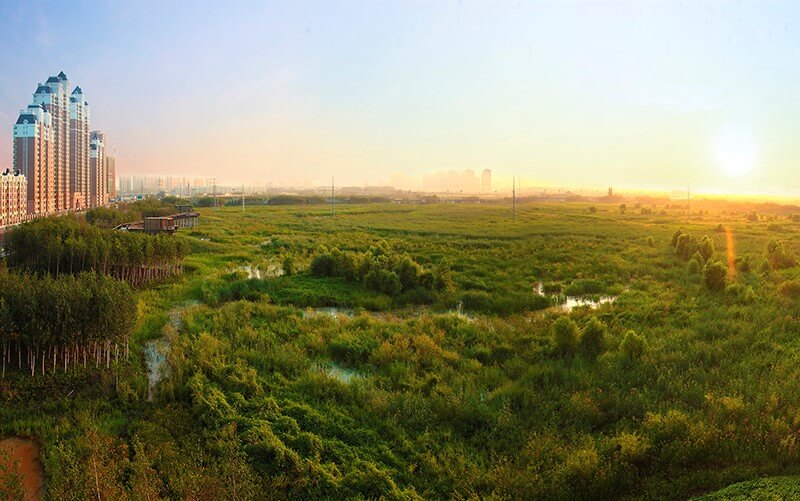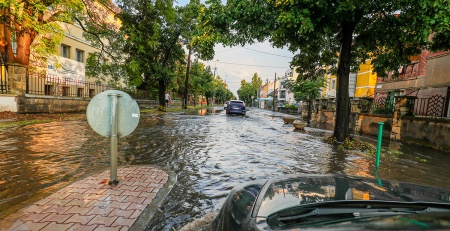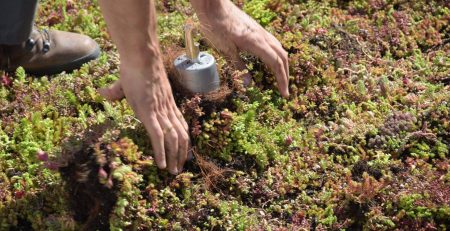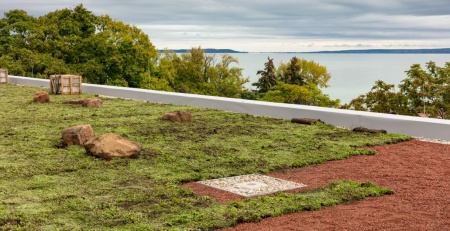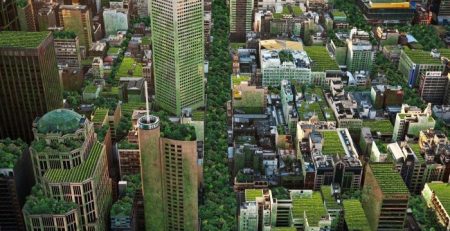News of the Green roof-World – Professional Practice
Green roofs can help regulate a building’s internal temperature, reduce stormwater runoff, and mitigate the urban heat island effect. Green roofs offer significant economic benefits, including a longer roof life and heating and cooling energy savings. Green roofs also provide an opportunity for urban food production, and increasing urban biodiversity. If well-designed and cared for, green roofs can offer people the psychological benefits of nature.
Green roofs’ benefits include:
Economic
- Green roofs can extend a roof’s lifespan by two or three times. According to Sustainable South Bronx, on a 90 degree day a green roof is about 80°F, while a black roof is 175°F, causing substantial wear and tear.
- A University of Michigan study showed that a 21,000 square feet $464,000 green roof will save $200,000 over its lifetime. “Nearly two-thirds of these savings would come from reduced energy needs for the building with the green roof.” (1)
Energy Use
- Energy savings: A typical 2-3 story building could experience 15-25 percent savings in summertime energy costs.(1)
Water Management
- Green roofs can catch 40-60 percent of stormwater, reducing flow into a city’s sewers (1)
- Green roofs led to approximately 65 percent reduced peak flows and 55 percent reduced runoff volumes, according to an E.P.A. overview of peer-reviewed literature. (2)
- Modelling conducted on Manchester, England, found that adding green roofs to all buildings in town centers, retail, and high-density residential could reduce run off by 17 – 20 percent.(3)
- The green roof on FedEx’s Main Sorting Facility at O’Hare covers nearly 175,000 square feet, captures close to two million gallons of stormwater annually, and will save the company an estimated $35,000 in energy costs per year. (4)
Reducing Air Pollution, Urban Heat, & Atmospheric Carbon Levels
- A study quantifying ecosystem services resulting from Portland, Oregon’s green infrastructure practices in 2009 found that green roofs reduced particulate matter less than 10 micrometers in diameter (PM-10) by 7.7 lbs, created 8,270 + kWh/Acre energy savings, and sequestered 7.1 metric tonnes of carbon emissions per acre per year. (5)
Urban Heat
- A modeling study found that adding green roofs to 50 percent of the available surfaces in downtown Toronto would cool the entire city by 0.2 to 1.4°F (0.1 to 0.8°C).(1)
- A Toronto study found two green roofs with minimal vegetation reduced peak summertime roof membrane temperatures by 35°F and summertime heat flow through roofs by 70-90 percent compared with a conventional roof, substantially reducing energy needs for cooling. (1)
- A study conducted at the University of Central Florida found the maximum average day temperatures for conventional roof surface was 130°F, while the maximum average for green roof was 91°F, which is 39°F lower than the conventional roof. (1)
Green walls include most of the benefits of green roofs, but also:
- Temperatures behind green walls can be reduced by as much as 10 degree celsius.
- Green walls can help reduce sound reflection
- Through shading, green walls can lower temperatures in summer and reduce energy costs by 23 percent. (6)
Sources:
1. “Reducing Urban Heat Islands: Compendium of Strategies, Green Roofs,” U.S. Environmental Protection Agency and Sustainable South Bronx
2. “The Illinois Green Infrastructure Study,” Illinois Environmental Protection Agency
3. “Microeconomic Evidence for the Benefits of Investment in the Environment – review.” Natural England
4. “Banking on Green: A Look at How Green Infrastructure Can Save Municipalities Money and Provide Economic Benefits Community-wide.” ASLA
5. “Portland’s Green Infrastructure: Quantifying the Health, Energy, and Community Livability Benefits,” Environmental Services, City of Portland
6. “Living Walls: A Way to Green the Environment” Susan Loh, Australian Council of Built Environment Design Professionals, August 2008
